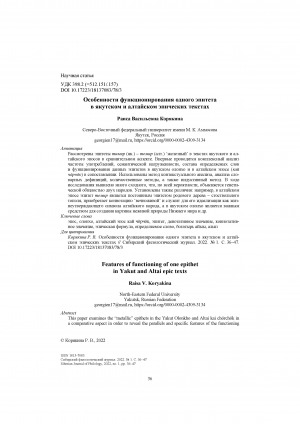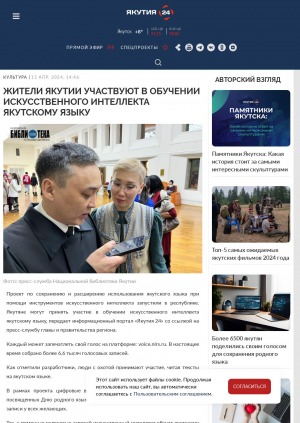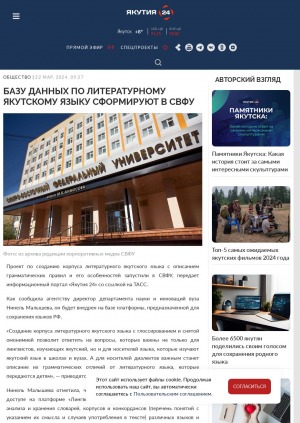Количество страниц: 15 с.
- Языкознание. Филология. Художественная литература > Языкознание и языки. Лингвистика > Якутский (саха),
- Языкознание. Филология. Художественная литература > Языкознание и языки. Лингвистика > Тюркские языки,
- НАУКА ЯКУТИИ > ЯЗЫКОЗНАНИЕ. ФИЛОЛОГИЯ. ЛИТЕРАТУРОВЕДЕНИЕ. ХУДОЖЕСТВЕННАЯ ЛИТЕРАТУРА > Языкознание и языки. Лингвистика.
In modern times, the functioning of languages in public space requires state regulation, the main goal of which should be the preservation and development of multilingualism and support of minority languages. The national politics in the field of preservation and development of the languages of the peoples of the Russian Federation is based on the implementation of a number of measures at the legislative level. Russia adopted the Law “On the Languages of the Peoples of the Russian Federation”; its national republics have their own laws on languages regulating the functioning of languages on their territory. In Yakutia, on October 16, 1992, Law of the Republic of Sakha (Yakutia) No. 1170-XII “On languages in the Republic of Sakha (Yakutia)” was adopted, a study on the implementation of which became one of the projects of the state program of the Republic of Sakha (Yakutia) “Preservation and development of state and official languages in the Republic of Sakha (Yakutia) for 2023.” The project “Monitoring the implementation and compliance with the requirements of articles of the Law on Languages in Yakutsk of the Republic of Sakha (Yakutia)” was proposed by the Department of Stylistics of the Yakut Language and Russian-Yakut Translation of the Institute of Languages and Culture of the North-East of the Russian Federation of the M.K. Ammosov North-Eastern Federal University. In order to implement the project, the department’s team developed a questionnaire on the articles of the Law “On Languages in the Republic of Sakha (Yakutia)” for two target audiences: specialists from organizations to whose work the articles of the Law are directly related, and the population. The purpose of the proposed work is to analyze the results of a survey conducted on articles 19, 20, 21, 22, 23, 33 among specialists of organizations and the population of the city of Yakutsk. The study used statistical and descriptive methods, as well as data processing and analysis methods. The results of the study are structured as follows: first, the full text of the considered article of the Law “On Languages in the Republic of Sakha (Yakutia)” is presented, then an analysis of a survey among employees of the institution and the results of a survey among the population are presented, followed by recommendations for the implementation of the article of the Law.
Собакина, И. В. К вопросу о функционировании Закона "О языках в Республике Саха (Якутия)" в городе Якутске (на материале результатов анкетирования по статьям 19-23, 33) / И. В. Собакина ; Северо-Восточный федеральный университет им. М. К. Аммосова, Институт языкови культуры народов Северо-Востока Российской Федерации // Вестник Северо-Восточного федерального университета им. М. К. Аммосова. Серия "Алтаистика". - 2024. - N 1 (12). - C. 26-40. - DOI: 10.25587/2782-6627-2024-1-26-40
DOI: 10.25587/2782-6627-2024-1-26-40
Количество страниц: 12 с.
В данной статье затрагиваются проблемы, связанные с неоднозначностью сложных предикатов в языке саха. Сложный предикат имеет структурно-семантическое отличие от составного. Также можно выделить функциональные вспомогательные глаголы, которые в семантическом плане выражают аспектуальные и модальные значения. Например, вспомогательный глагол бар-‘уходить’ прибавляется к деепричастию с аффиксом {-Ан}: ааҕан бар- ‘начинать читать’, выражая тем самым начало действия. Функциональные вспомогательные глаголы являются результатом грамматикализации в языке саха, но данный процесс в языке не был до конца завершен. Таким образом, возможно двоякое толкование предиката аhаан бар- как Һначать естьһ (сложное) и Һсъесть и уйтиһ (составное).
Torotoev, G. G. Discussion oncomplex predicates in the Sakha language / Kang Ducksoo, G. G. Torotoev ; Университет иностранных языков "Хангук", Северо-Восточный федеральный университет им. М. К. Аммосова // Вестник Северо-Восточного федерального университета им. М. К. Аммосова. Серия "Алтаистика". - 2024. - N 1 (12). - C. 5-16. - DOI: 10.25587/2782-6627-2024-1-5-16
DOI: 10.25587/2782-6627-2024-1-5-16
Издательство: ИД СВФУ
Год выпуска: 2014
Количество страниц: 160 с.
Количество страниц: 12 с.
The paper examines the linguistic and cultural semantics of the Yakut word buruo (smoke) by exploring its metaphorical manifestations in vocabulary, phraseology, and folklore. The folklore text is analyzed using a structural-semiotic approach to examine language as a cultural verbal code. For the first time, the smoke metaphor is recognized as a source of riddles, proverbs, good wishes, incantations, euphemisms, and others. Otherwise, the metaphor is found to have meaning- and text-forming functions. In the Yakut linguoculture, the smoke metaphor creates a micro paradigm of linguistic units with the general semantics of “descendants, a continuation of the family.” The metaphor under study is suggested to be a cultural element of the Sakha people’s folklore, specifically related to the patriarchal family structure and the roles of sons and daughters in procreation. The smoke metaphor, a tool for creating new concepts and pictorial means in language and culture, proves to be an element of the informational structures of oral collective memory. It preserves the principle of patrilineage, gender stereotypes, and traditional ideas of the Sakha people about the succession of generations and procreation, understood as “development, advancement through stages of development.” A significant finding is that a polysemous word, phraseology, paremy, epithet, folklore formula, symbol, and others can preserve considerable information in a coiled form and serve as an optimal way of its oral transmission in time and space. To conclude, folklore text meta-phors are not only emotionally rich but also involve “condensed” meaning, with a symbol representing the information compression.
Габышева, Л. Л. Метафора дыма: реконструкция культурных смыслов (на материале якутской лингвокультуры) / Л. Л. Габышева ; Северо-Восточный федеральный университет им. М. К. Аммосова // Сибирский филологический журнал. - 2024. - N 1. - С. 236-247. - DOI: 10.17223/18137083/86/17
DOI: 10.17223/18137083/86/17
Количество страниц: 14 с.
The paper presents a structural description of the terminological phrases relating to the thematic group “Livestock body parts” in the Yakut and Buryat languages. These lexical units refer to the folk terms reflecting the features of the material and spiritual culture of an ethnic group and are widely used in languages of very different typologies. Such phrases are formed analytically, representing non-single-word nominative units denoting one specific concept or real object. Their lexical meaning can be realized at the denotative and/or connotative levels. The terminological phrases under study occupy a special place in the lexicon of the languages in question as an effective way of creating terms. Word pairs are a part of this vocabulary group. An active way of compound word formation in Yakut and Buryat is the method of adjunction used to form attributive phrases with an adjective or a participle as an attribute. Both languages feature terminological phrases formed morphologically. Such phrases have an attributive function, designating a part of a whole object or a type of a generic concept, with the determining component occupying the preposition. In Yakut, these phrases have their components connected by the possessive affix of the third person. Buryat terms denoting animal body parts are formed by a combination with the determining component in the genitive case. It is noteworthy that in Yakut nominal constructions, the indicator of the connection between the components is attached to the component being determined, while in Buryat, it is attached to the determining one.
Данилова, Н. И. Терминологические словосочетания, обозначающие части тела скота, в якутском языке (в сопоставлении с бурятским) / Н. И. Данилова, Ф. Н. Дьячковский ; Институт гуманитарных исследований и проблем малочисленных народов Севера // Сибирский филологический журнал. - 2023. - N 4. - С. 197-210. - DOI: 10.17223/18137083/85/15
DOI: 10.17223/18137083/85/15
Количество страниц: 14 с.
This paper addresses the semantics of dialectal names of mutovka (a stick with branches at the end used for mixing or stirring), with all of them belonging to the lexical-thematic microgroup “Utensils” in the Yakut language. Over 40 dialect names of mutovka with different connotations have been identified in dialectological, lexicographical, and ethnographic materials. The nomination principles of mutovka are determined on the external form and functions. The form and structure of mutovka s (round, branched, cross-shaped), material (wood, cow horn) depend on their purpose. Mutovka has different functions: for whipping koumiss, cream, or butter, and others, with the movement of the tool also of importance for nomination. The basic characteristic of any mutovka is ytyyyy “mixing, stirring, and churning.” The comparative analysis revealed that the Yakut lexemes ytyk and bhiheyeh indicate a common Turkic similarity. Most names of mutovka are part of the lexical fund of the Yakut language developed in the linguistic landscape of modern Yakuts (Sakha). Also, the dialect names bilier, biriel “kumys mutovka” have been found to have Mongolian roots. A semantic description allowed the origin of khamnatar “kumys mutovka” to be determined as an apotropaic lexeme with both all-Yakutian and dialectal meaning. The semantics of the mutovka names concerned reflects the cattle-breeding culture of Yakuts (Sakha) developed and spread in the subcontinental climate in the vast territory of the North-East of Russia. The findings specify the lexical-semantic microgroups “Tableware,” “Utensils” to “Kumys ware and utensils,” “Ytyk,” to compile the thematic lists of Yakut household culture.
Николаев, Е. Р. Диалектные наименования мутовки в якутском языке (на материале лексикографических источников) / Е. Р. Николаев ; Институт гуманитарных исследований и проблем малочисленных народов Севера // Сибирский филологический журнал. - 2023. - N 2. - С. 194-207. - DOI: 10.17223/18137083/83/15
DOI: 10.17223/18137083/83/15
Количество страниц: 12 с.
- Языкознание. Филология. Художественная литература > Языкознание и языки. Лингвистика > Якутский (саха),
- Языкознание. Филология. Художественная литература > Языкознание и языки. Лингвистика > Другие языки,
- НАУКА ЯКУТИИ > ЯЗЫКОЗНАНИЕ. ФИЛОЛОГИЯ. ЛИТЕРАТУРОВЕДЕНИЕ. ХУДОЖЕСТВЕННАЯ ЛИТЕРАТУРА > Языкознание и языки. Лингвистика.
This paper examines the “metallic” epithets in the Yakut Olonkho and Altai kai chӧrchӧk in a comparative aspect in order to reveal the parallels and specific features of the functioning of these epithets in the epic of peoples related in the historical past. The following methods were used: contextual analysis, analysis of dictionary definitions, quantitative methods, and the inductive method, which allows generalizing the results of applying all the methods. The comparative study revealed many similarities. In both epics, metal epithets in the structure are radical, derived from the lexeme denoting the name of the metal. In a denotative meaning, they characterize objects by the material from which they are made. The choice of specific metallic epithets as contextual synonyms in the structure of the epic formula is due to the phenomenon of vowel harmony inherent in most Turkic languages. The genetic community of the Yakut and Altai peoples probably explains the similar features of the metallic epithets. Also, the differences have been established: according to the frequency of using the epithets formed from the nominations of precious metals, the ancient Yakuts preferred silver, and the Altai people preferred gold. The differences and peculiarities of functioning of “metal” epithets in the Yakut and Altai epic texts can be explained by the stage difference in the development of the epic texts compared.
Корякина, Р. В. Особенности функционирования одного эпитета в якутском и алтайском эпических текстах / Р. В. Корякина ; Северо-Восточный федеральный университет им. М. К. Аммосова // Сибирский филологический журнал. - 2022. - N 1. - С. 36-47. - DOI: 10.17223/18137083/78/3
DOI: 10.17223/18137083/78/3
Год выпуска: 2024
Год выпуска: 2024
Год выпуска: 2024









